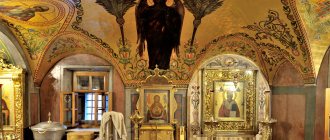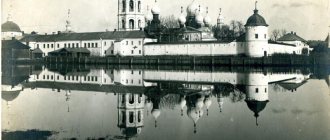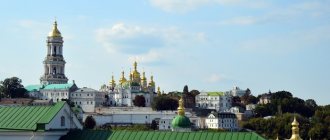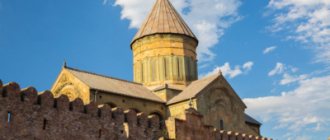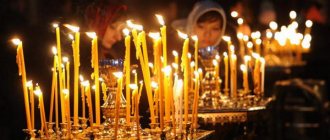| St. Shio Mgvimsky. Icon end.XX-beginning. XXI centuries |
Shio (Simeon) Mgvimsky
(Georgian შიო; -VII centuries) Venerable Memory May 9, February 9 (OCA [1]), March 3 (OCA [2]), on Thursday of Cheese Week and among the 13 Syrian Fathers
Born in Antioch of Syria. His parents were Christians and raised their son as the only heir. The young man received a good education, studied the Holy Scriptures, and already in his early years was gifted with the ability to interpret the Word of God. Having learned about the holy ascetic John, Shio secretly left his parents' house and went to him. The Monk John sent the young man back to his parents, predicting that they would become monks. The prediction soon came true. Then Shio distributed the inheritance and took monastic vows from Saint John.
20 years later, the Monk Shio, along with 12 other selected disciples of St. John, went to Georgia to preach the Word of God. With the blessing of the Catholicos of Georgia Evlavius and his teacher, the Monk Shio settled in a cave west of the city of Mtskheta, where he carried out severe ascetic labors, for which he was awarded miraculous visions. It became known about the solitary life of the ascetic, and soon the place of the saint’s feat turned into a monastery, in which he founded a temple in the name of the Most Holy Trinity. Later, churches were also erected in honor of the Mother of God and John the Baptist. All of them were consecrated by Catholicos Macarius. The number of brethren increased, and the monk blessed the founding of the Mgvima monastery for them, while he himself continued the feat of salvation in seclusion.
The Monk Shio reposed on May 9, having received the Holy Mysteries on the eve and teaching the last saving instructions to the brethren. The relics of the saint of God were buried in the monastery he founded.
| St. Shio Mgvimsky. Fresco (2004) in the church of St. Hilarion the Great, Optina Pustyn |
The biography of Shio was compiled by his associate Martyrius the Greek (in the world John);
it was originally written in Greek and sent from Constantinople to Georgia. Both this biography and Shio’s two prayers should be classified as the only surviving monuments of ancient church Georgian writing, after the biography of Equal-to-the-Apostles Nina. The Monk Shio is known as the author of 160 teachings for the brethren.
Orthodox Life
On May 22, the Georgian Orthodox Church honors the memory of Saint Shio of Mgvim, one of the founders of monasticism in Georgia. Like the first monks of Kievan Rus, the Christian hermits of Transcaucasia secluded themselves in caves, and one of such pillars of the faith of Iberia became Shio Mgvimsky, or Pechersky, because mgvime in translation from Georgian means cave.
The Shio-Mgvim Monastery is one of the oldest not only in Georgia, but throughout the Christian world. Founded in the 6th century, it is still in operation, and it contains prayer and glorification of God. It is not for nothing that many Georgians believe that with the revival of this monastery, the revival of the Georgian Church in our time began.
The ancient monastery is located 9 km from the city of Mtskheta, the ancient capital of the Georgian kingdom, in a narrow limestone gorge, and it can only be reached by one single road. Regular transport never travels along this mountain serpentine, and only a few years ago the ancient road became paved and convenient for the arrival of pilgrims. The monastery, even in the 21st century, looks like a monastery and a place of hermitage; there are no crowds of people or bustle. In general, this place is ideal for a monastery, taking into account the fact that before it was much more remote and the place was inhabited by wild animals. Few people know that tigers and leopards lived in Georgia, and the word Georgia itself (Gurjistan, Gurzan) was called “the country of wolves” by the Arabs and Persians.
Saint Shio is one of the great 13 Assyrians who came from Antioch at the end of the 5th century to preach Christ. Saint John, by the will of God, chose twelve disciples to evangelize in Iberia. One of these followers was Shio, and the name itself became a derivative of Shimon, Simeon. The saint went for solitary prayer to the gorge, which later became a famous monastery in his honor. Saint John said these words to Shio: “My child! Go where the Lord Himself leads you. Our Lord Jesus Christ showed me that you must lead a solitary life, and meanwhile you will be the Abba of the great Lavra.” These words turned out to be prophetic; already at the end of the 6th century the monastery was inhabited by more than 2000 monks!
The righteous man did not seek glory and honor from people, but most of all wanted to communicate with God. He lived secretly in a cave and was one day found under miraculous circumstances by a certain Evagrius, the commander of the fortress. While hunting with his servants, he noticed that a dove was carrying food in its beak and flying into a cave. There he found a man praying, and it was the great Shio. The bird fed the hermit, just as the crows fed the Old Testament prophet Elijah. After communicating with the saint, Evagrius completely changed his life, sold off his estate and distributed it to the poor, dug himself a new cave and remained here to live as a monk. Subsequently, he will become the abbot of the monastery, which is formed from like-minded people and followers of Shio. And now on the high sandy slopes you can see these caves, where hermits lived in ancient times.
Saint Shio is often depicted in icons with a wolf, and this is not an allegory at all, but evidence of a miraculous episode from his life. The monks complained to the saint that wolves often attacked the monastery flock. The saint prayed, and, as the legend says, he told the wolves who had gathered from the forest not to disturb the brethren and to leave these places, but one wolf needed to stay and protect the herd for the damage caused. And so it happened: the wolves no longer bothered, and the only wolf guarded the herd for six years and did not eat meat until another incident occurred. One day the donkey crashed into the abyss, but one of the monks began to tell the saint that it was the wolf that ate him. After the truth became clear, the saint told the wolf that he was free, and since then the predator went into the forest and did not appear.
There is an interesting case of finding water. The monks needed water; they carried it from afar up the road. Once a monk broke clay vessels with water and cried from fatigue and sorrow. Through the prayer of the Monk Shio, a spring began to flow near the caves, which was called “Tears of Shio.”
Sometimes the saint is depicted with smoking incense on his hand, and this is also connected with the legend about the construction of the first temple, which has survived to this day! Shio himself chose the place to lay the temple in honor of John the Baptist, and for this he put burning incense on his hand and went where the smoke pointed. This is the very first building of the Shio-Mgvim monastery and was built in the period 560–580.
The Monk Shio spent the last years of his life in seclusion. Before this, he wrote 160 sermons that the brethren were supposed to read on Sundays. After the creation of the monastery, he secluded himself for 15 years in a cave near the temple, not going out into the world and eating only water and prosphora. At the end of his life, he intensified his ascetic deeds and lived in a cave that looked like a well, and there he went to God. His relics were preserved in this place for many centuries and were a place of veneration.
The monastery flourished during the reign of King David IV, who made the Shio-Mgvima monastery his royal possession, and the monastery became the center of cultural and religious activity in Georgia. The Church of Our Lady, built around 1100 on the initiative of David the Builder, has also been preserved, and is now the central temple of the monastery. From the chronicle of 1202 it is known that Bishop Anton, under Queen Tamara, built a 2-kilometer water supply for the monastic community, stretched from a neighboring village. As for the Church of the Mother of God, its appearance was changed after the destruction of the dome during the invasion of the Persian Shah Abbas I in 1614. 65 years later it was restored, but in a simplified form, like a basilica. Some frescoes and paintings have been preserved, and although the temple is quite minimalist and simple in its architecture, it is impressive inside. And venerable age itself inspires respect.
In later times, the monastery was attacked and plundered by the Arabs and Persians. Once, under Shah Abbas II, the relics of Saint Shio were taken away along with valuables. A pestilence of inhabitants began in Persia and for three years all the first-born children of people and animals in the country died. An old man appeared to one of the Persian sages in a dream and said: “Aren’t you tired of suffering? Return my remains to Georgia!” The Persian told the ruler about this and the fact that he was another subject, and clarified that he was not afraid to speak about it like others, since he was already old and ready to lay down his life for the truth. The Shah ordered the relics of Saint Shio Mgvimsky in a golden shrine to be returned to Georgia. As soon as the caravan with the relics crossed the border of Iran, the pestilence stopped. Remembering this event, the Iranians, right up to the Bolshevik revolution, donated a very large sum to the monastery in honor of this event.
After the Persian invasion, Prince Givi Amilakhvari restored the monastery in 1678, but already in 1720 the Ottoman occupation of Georgia led to another destruction of the monastery. Resuming in 1733, it was again destroyed by the Persians. The Shiomgvime Monastery was revived, but the monastery was never able to regain its past significance in the spiritual life of Georgia. The Shio-Mgvim monastery existed until the 19th century and after the Lezghin raids it was deserted, but after a while it was revived again by Bishop Alexander. During the Soviet period, persecution of the monastery began. There is a known case about the abbot of a monastery, who was shot after he refused to let drunken soldiers into the walls of the monastery. The last monks lived here under Soviet rule until about the 1960s. The relics of Saint Shio were kept in the monastery for one and a half thousand years, except for the above-mentioned event with the Persians, until the 20th century, when someone’s godless hand rose to the shrine and organized arson. Some of the relics survived and are now in the Samtavro Monastery near Mtskheta. For thirty years the monastery was completely empty, and the revival of monastic life occurred in the 90s of the last century.
If a believer comes to this place, he is impressed not only by the beauty of the place, clean air, silence, the height of the mountains and hills (the monastery is located at an altitude of 750 meters above sea level), not only by ancient temples and caves, but by the place itself, consecrated by prayers righteous people, the most famous of whom is the holy righteous Shio.
Andrey German Photo by the author
How to get there[edit]
Directions:
You can get to the monastery from Mtskheta - there is a sign to the monastery on the central square of the city. There is only one road, a dead end and no regular transport.
You should walk from the village of Dzegvi on the Mtskheta-Kavtiskhevi highway. There is a bridge over the Kura and further up the road to Shiomgvime begins. From Dzegvi 4 kilometers. You can get there from Ksani. You can get there off-road from the north through the ridge, from the village of Chardakhi in the Mukhrani Valley through the village of Skhaltba. Also 4 kilometers. When moving from the north, you find yourself right on the edge of a cliff, from where there are stunning views of the monastery and the surrounding area, but it is difficult to go down from there - you will have to walk through the forest.
Address:
Mtskheta, Mtskheta-Mtianeti
Story
The Shio-Mgvim monastery appeared in the historical period when the Assyrian fathers dispersed throughout Georgia. Saint Shio came to the gorge near the city of Mtskheta. He began to live in one of the mountain caves. Quite quickly he acquired many followers. They dug caves for themselves. There are a lot of them preserved in the vicinity of the Shio-Mgvim Monastery; the exact date of their creation is very difficult to determine at the moment.
His famous follower was Evagrius. He owned the Tsikkhedidi fortress. He met Shio when he went hunting in the highlands. Having met the saint, Evagrius decided to stay with him. At the same time, he put up for sale everything he owned. He gave all the money he collected to the poor and began to live a monastic life.
Reviews
The cells here are located opposite the temple. Today, approximately several dozen monks live in them. They are quite modern buildings. Once upon a time, about 2,000 novices lived in this monastery. The monks, which is generally characteristic of the Georgian nation, welcome guests with all cordiality. You can visit the monastery for free; the monks themselves volunteer to conduct excursions. Visitors note that these excursions are extremely interesting, imbued with love and passion for these places and their rich history.
The novices provide for their own living by raising sheep and grapes. They cultivate the land. It is likely that they will offer to try the local wine that they make themselves. For Georgian monks, making wine is a kind of religion. By giving the visitor wine, they actually bare their soul to him. In their reviews, many note the purity of the mountain air, the beauty of the local landscapes and the incredibly calm atmosphere of the monastery, which is why tourists love this place so much.
Additional buildings
In addition to these religious buildings, several ancient buildings intended for farming have been preserved on the territory of the monastery. Also visible in the photo of the Shio-Mgvim Monastery in Georgia is a church located high on the rocks. It's quite difficult to get to. There are no springs here.
Today, novices live in the monastery, and the rules there are quite strict. For this reason, the best solution for tea ceremonies is to move to the south, outside the gate.
There are many caves in the cliffs of the surrounding area. There is sedimentary rock, limestone, sandstone. For this reason, digging a cave does not seem difficult. However, it remains unclear how exactly you can get to the caves from the monastery. It is likely that such actions are not welcome here.
When arriving at the monastery, you need to take into account that they bring medicinal oil from the Shio-Mgvim Monastery. You can buy it here, it is popular.
About the second temple
The Temple of Our Lady was built around 1100 by David the Builder. At the moment, this particular building is considered central in the monastery. Initially, this temple had a dome. However, when Shah Abbas attacked this area in 1614, the structure was destroyed. It was restored only in 1678. Then it acquired a simplified form.
The temple remained simple, without any special frills or external decorations. It is built in a minimalist style. But the interior decoration is beautiful. There are many frescoes and paintings left there. Someone once pasted photo wallpaper on the walls and traces of this remained. Photography is prohibited inside this building.
